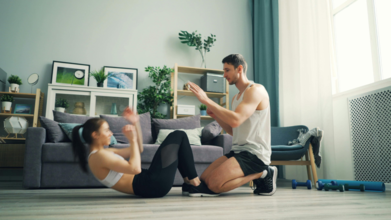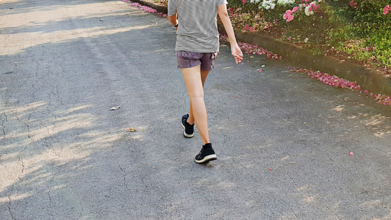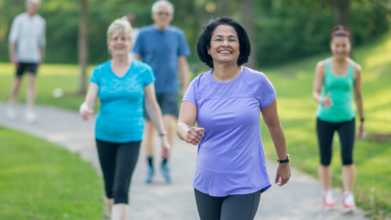- Health Conditions A-Z
- Health & Wellness
- Nutrition
- Fitness
- Health News
- Ayurveda
- Videos
- Medicine A-Z
- Parenting
- Web Stories
This Type Of Yoga Involves A Venomous Reptile—Would You Do It?

Credit: Canva
There's no doubt that yoga has evolved over time. While styles like power yoga, hot yoga, and aerial yoga are already popular, a new trend has now gone viral. This new form encourages people to relax while snakes slither across their backs. Intrestingly, one yoga studio, LXRYOGA, located in California, US, has already gained a lot of popularity with its 'Snake Yoga' classes.
This class particularly targets those who suffer from ophidiophobia, a fear of snakes. According to the proprietors of the place, the purpose of this form of yoga is to help people overcome the fear of snakes through breath. "Some might say our offering is a gimmick like other animal-incorporated yoga, but we truly believe in what we offer, Tess Cao, co-owner of the studio, told People.
Owners of LXRYOGA, Tess and Huy, have already added a unique twist to these classes by making their pet ball pythons a part of the sessions. According to NY Post, these 45-minute classes, priced at US$160, offer a serene experience where participants practice gentle yoga alongside six snakes, each named after crystals. Before the session, participants draw a crystal to determine which snake will be their partner for the class.
Tess explains that the snakes, known for their social and friendly nature, are carefully introduced to ensure they feel comfortable and relaxed. To avoid any potential stress for the animals, an orientation is held before each class, teaching participants how to handle the snakes and, equally important, what not to do. The owners have repeatedly asserted that the sankes are amicable and there has not been a single case where they have bitten someone.
Not only do the participants handle the snakes, but they allow the slithering creatures to roam their bodies while they’re still. "Savasana — where students lie down on their backs with eyes closed, while snakes are placed on their bodies — feels like a ‘Fear Factor’ episode, but most say it’s grounding and relaxing, owners said. They underscore that while some may take their class for fun, many are curious about snakes. Moreover, there are many who want to overcome their fear of snakes.
How Does Snake Yoga Benefit You
- Practicing snake or any form of yoga helps increase flexibility, reducing stiffness and enhancing range of motion in the muscles and joints.
- Yoga promotes relaxation and mindfulness, reducing stress, anxiety, and depression while improving overall mental well-being.
- Many yoga poses strengthen muscles and improve balance, which can help with posture and prevent falls, especially as you age.
- Focused breathing techniques in yoga help improve lung capacity, regulate breath, and enhance overall respiratory function.
- Moreover, yoga can lower blood pressure, improve circulation, and reduce the risk of heart disease by promoting relaxation and reducing stress.
How Many Crunches Can You Do As Per Your Age?

Credits: Canva
Core strength plays a vital role in daily function, athletic performance, and long-term health. Beyond aesthetics, a strong core supports posture, protects the spine, and enhances balance and mobility.
Among the most effective and accessible core exercises is the crunch, a movement that directly engages the abdominal muscles.
According to fitness experts, the number of crunches you can perform at once may reveal important insights about your strength, endurance, and overall health status.
What Exactly Is a Crunch?
Though a simple exercise, the crunch remains a foundational core exercise.
To perform it correctly, lie on your back with your knees bent and feet flat on the floor.
Using the abdominal muscles, lift the shoulders off the ground while keeping the lower back anchored.
Unlike a sit-up, which involves a greater range of motion, the crunch isolates the rectus abdominis (commonly known as the “six-pack” muscle) and obliques.
This targeted approach makes it one of the most efficient movements for strengthening and toning the midsection.
Why Crunches Matter for Health
Crunches are not only a tool for achieving a toned core but also a means of preserving physical function as we age. The abdominal muscles play a critical role in stabilizing the body during movement, protecting the lower back, and ensuring balance.
Weak core muscles are often linked to poor posture, chronic pain, and reduced mobility, particularly in older adults. Maintaining crunch capacity can therefore be viewed as a marker of overall physical resilience.
ALSO READ: Master Burpees With These 6 Easy-To-Follow Steps
Recommended Crunch Benchmarks by Age
The number of crunches you should be able to complete in one attempt varies by age group. Muscle mass and endurance naturally decline with age, but maintaining regular activity helps preserve function and strength.
20s: At this stage, core muscles are at their peak. Adults in their twenties should aim for 40 to 50 consecutive crunches. This level reflects optimal endurance and strength, supporting demanding physical activities.
30s: By the thirties, lifestyle factors such as work and family obligations can reduce available time for fitness. A benchmark of 30 to 40 crunches indicates good maintenance of core health during this period.
40s: Metabolism begins to slow, and muscle recovery may take longer. Adults in this age group should aim for 20 to 30 crunches per session to ensure continued strength and spinal support.
50s: In the fifties, the focus shifts to preserving strength and mobility. The target range is 15 to 25 crunches, complemented by low-impact activities such as swimming or yoga to reduce strain on the joints.
60 and above: Older adults should strive for 10 to 20 crunches in a single sitting. This range emphasizes maintaining mobility, balance, and independence in daily life.
How to Maximize Results
Performing crunches once in a while is insufficient for significant gains. To build true strength, experts recommend at least three sets of crunches a few times per week.
Combining crunches with planks, leg raises, and rotational exercises provides a more complete core workout. For variety and long-term engagement, activities such as Pilates, yoga, and dance also deliver excellent results for core development.
What Fewer Crunches Could Indicate
If meeting the minimum benchmark for your age group feels impossible, it may highlight underlying concerns. Struggles with crunches can signal poor cardiovascular fitness, musculoskeletal imbalances, or back issues. Difficulty may also suggest that the body requires more consistent training and conditioning.
Addressing these gaps early helps prevent further health complications and supports an active lifestyle.
For beginners or those with limitations, modifications such as pelvic tilts, knee-supported planks, and lying leg raises are safe entry points into core training. Gradual progression from these foundational movements can eventually build the capacity to perform more demanding exercises like crunches without strain.
A Small Tweak In Your Daily Walk Can Protect Your Knees From Osteoarthritis

Credits: Canva
Osteoarthritis is often dismissed as an inevitable part of aging, but for millions, it’s far more than a minor inconvenience. The degenerative joint disease affects nearly one in four adults worldwide, making it one of the leading causes of disability. At its core, osteoarthritis happens when the cartilage that cushions the ends of bones wears down, leaving joints stiff, painful, and less mobile.
Treatment has long followed a frustratingly predictable path: lifestyle adjustments, pain medication, physical therapy, and eventually surgery. There is no cure and no way to reverse the damage. For patients diagnosed in their 30s, 40s, or 50s, the reality often means decades of pain management before they’re considered for a joint replacement but new research suggests a surprisingly simple, non-invasive alternative: retraining the way you walk.
In a year-long clinical trial led by researchers at the University of Utah and published in The Lancet Rheumatology, scientists tested whether small changes in walking style could reduce pain and slow disease progression in people with knee osteoarthritis.
The results were eye-opening. Patients who adjusted their foot angle while walking—essentially pointing their toes slightly inward or outward, depending on their natural gait—reported pain relief equivalent to medication. Even more compelling, MRI scans revealed less cartilage degradation in these patients compared with a control group.
Dr. Scott Uhlrich, one of the study’s lead authors, explains, “We’ve known that higher loads in the knee accelerate osteoarthritis progression, and that changing the foot angle can reduce that load. What’s new here is showing, in a randomized, placebo-controlled trial, that it truly makes a difference for pain and cartilage health.”
How Walking Mechanics Affect the Knee?
To understand the promise of this intervention, it helps to look at the knee itself. The knee has two main compartments: medial (inner) and lateral (outer). The medial side typically bears more weight, making it especially vulnerable to wear and tear.
By subtly changing how the foot strikes the ground, the force distribution within the joint shifts. In the study, researchers used motion-capture cameras and pressure-sensitive treadmills to determine whether each participant should angle their toes inward or outward, and by how much. For some, a five-degree adjustment worked best; for others, 10 degrees was more effective.
Participants who showed no improvement in knee loading with adjustments were excluded, underscoring that the technique isn’t universal. For those who responded, however, the results were profound.
Personalized Gait Training in Action
The study included 68 adults with mild-to-moderate osteoarthritis in the medial knee. Half were assigned to a control group receiving dummy treatment, while the intervention group received personalized gait retraining.
Those in the intervention group attended six weekly training sessions, where wearable sensors delivered real-time feedback via vibrations on the shin to keep them aligned with the prescribed foot angle. Afterward, they were encouraged to practice their new gait for at least 20 minutes daily until it became second nature.
A year later, patients reported significantly less pain, comparable to taking ibuprofen or even a prescription opioid. More importantly, their MRIs showed slower cartilage degradation a critical factor in delaying surgery.
Why Walking Is Crucial for Long-Term Care?
One of the biggest challenges in osteoarthritis treatment is the “care gap.” Patients too young or not yet severe enough for surgery often face years of medication dependence. Medications can mask symptoms, but they don’t address the underlying mechanics of joint stress.
Gait retraining could fill this gap. Unlike drugs, which can cause side effects, or surgery, which is invasive and costly, walking adjustments are safe, accessible, and potentially sustainable over decades.
“This is an intervention that people can realistically stick with,” says Dr. Uhlrich. “It could change the trajectory of care for people facing osteoarthritis earlier in life.”
For now, gait retraining requires specialized technology like motion-capture systems and pressure treadmills, but researchers are working to make it more practical. New approaches include smartphone-based video analysis and “smart shoes” equipped with sensors to monitor gait in real time.
If these tools become mainstream, patients could undergo assessment and training in clinics—or even at home—without the need for expensive equipment.
Walking as Medicine
Beyond osteoarthritis, walking itself is a powerful form of preventive medicine. Studies consistently link daily walking with improved cardiovascular health, better blood sugar control, stronger bones, reduced anxiety, and longer lifespan. The Centers for Disease Control and Prevention (CDC) recommends at least 150 minutes of moderate activity each week, and walking is one of the simplest ways to meet that goal.
What this new research adds is the understanding that how we walk is just as important as how much. The right mechanics may protect joints, relieve pain, and extend mobility for years.
While gait retraining isn’t yet widely available as a clinical service, the findings offer a hopeful glimpse of the future. Patients diagnosed with knee osteoarthritis can already benefit from conversations with physical therapists about gait mechanics, strength training, and weight management—interventions that reduce stress on the knee.
Crucially, experts caution against self-diagnosing or dramatically altering walking patterns without guidance. Not all knees respond the same way, and the wrong adjustment could potentially add strain elsewhere in the body.
Still, the study underscores a larger point: osteoarthritis doesn’t have to mean an inevitable decline toward surgery. With targeted interventions, patients may be able to rewrite their prognosis, staying active and pain-free longer than ever thought possible.
Knee osteoarthritis has long been treated as a condition to manage, not modify but evidence now shows that something as simple as a shift in how we walk could rival medication in reducing pain and slowing joint damage.
How Much And How Fast Do You Need To Walk For Your Heart Health? Shorter Walks Also Help

(Credit - Canva)
Walking is one of the best exercises we do. Not only is it cost effective, it needs minimal gear and has many health benefits. Walking for heart health is a great idea and has been shown to be very effective. However, there has been some discourse surrounding how many steps you need and how you should walk for maximum benefits.
We have seen the rise of walking trends like Japanese walking, 6-6-6 walking, backward walk etc. However, walking for health benefits doesn’t always have to be an elaborate affair. All you need is to make sure you are walking a certain amount of steps at a certain speed.
A new study suggests that you don't need to walk the often-recommended 10,000 steps to make a difference. The research found that even walking fewer steps each day—and picking up the pace a bit—can significantly lower your risk of major heart problems. The study is one of the first to show a clear link between the number of steps you take and the risk of heart and blood vessel issues.
How Many Steps Do You Need For Heart Health?
The study followed over 36,000 older adults with high blood pressure. Each participant wore a device for a week to track how far and fast they walked. Over an eight-year period, the researchers recorded nearly 2,000 heart problems or stroke incidents.
The findings, published in the European Journal of Preventive Cardiology, showed a clear link between daily steps and a lower risk of heart problems.
Every 1,000 steps added per day (starting from 2,300 steps) was linked to a significant drop in risk. This included a 17% reduction in overall heart risks, a 22% drop in heart failure risk, a 9% reduction in heart attack risk, and a 24% lower risk of stroke.
More is still better. While the benefits started at low step counts, they continued to increase with more steps, though not always at the same rate.
Walking faster helps. Participants who walked at a brisk pace of 80 steps per minute for 30 minutes a day had a 30% lower risk of a major heart problem. Those who walked even faster (130 steps per minute) had no major heart events at all. Similar benefits were also found in people who did not have high blood pressure.
Why Walking Is So Good for Your Heart
Walking is a simple yet powerful exercise that improves your health in many ways.
It strengthens your heart
Regular walking makes your heart stronger and better at pumping blood. Your blood vessels also become healthier, which helps your heart work more efficiently.
It improves your blood markers
Walking can help lower cholesterol, blood sugar, and a type of fat in your blood called triglycerides. It also helps reduce inflammation in your body.
Brisk walking boosts the benefits
Walking at a faster pace makes your heart and lungs work harder, which further improves your fitness, lowers blood pressure, and helps with weight management.
While the goal is to walk as much as you can, even small actions can add up. Here are some simple ways to fit more walking into your daily life:
- Swap short car trips for a walk.
- Take your dog for an extra walk and try to increase your pace at times.
- Park a little farther away from your destination.
- Choose the stairs over the elevator and take them a bit faster than usual.
- Walk around the house while you're on a phone call.
© 2024 Bennett, Coleman & Company Limited

